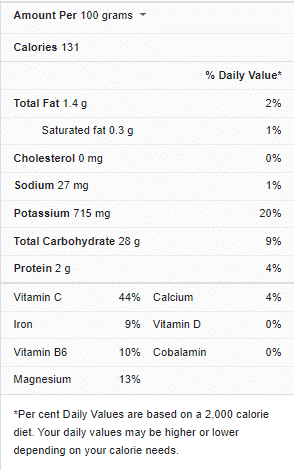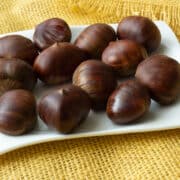Updated on October 15th, 2022
Chestnuts are safe to eat nuts of the Castanea family of shrubs and trees. They have a delectable, gently sweet flavor and are extremely adaptable. They can be used in a variety of meals, including stuffings, salads, soups, and more. Chestnuts come in a variety of shapes and sizes, yet they all have identical characteristics. American chestnut, Chinese chestnut, Japanese or Korean chestnut, and European chestnut are the most prevalent varieties.
Chestnuts are not just a tasty treat, particularly during the holidays, but they’re also high in nutrients connected to a variety of health advantages. This is possibly why so many people around the world prefer it as a nut. However, if you want to make a recipe out of it and are unsure how to do so, continue reading to see how simple it is.
Chestnuts Nutrition Facts

Why Chestnut?
Among so many perks that chestnut brings in terms of nourishing and seasoning not only your delicacy but also your health, are the following:
It can aid in diabetes prevention- Most individuals have no understanding of how important dietary fiber is in the control, prevention, and management of diabetes. Low glycemic foods, such as chestnuts, have a lower blood sugar spike than high glycemic ones. This helps diabetic people avoid severe blood sugar spikes and decreases, which are typically precursors to the development of diabetes in those who are not currently ill.
It may aid in the improvement of brain function- The eating of chestnuts improves brain function and cognition in a variety of ways. To begin with, these nuts are rich in B vitamins (folate, riboflavin, and thiamine), all of which are essential for optimal cognitive growth and functioning. Additionally, the potassium in chestnuts can improve blood flow to the brain and improve nervous system health, resulting in improved focus, recall, and memory.
It may aid in the management of blood pressure- Potassium is one of the most important nutrients for decreasing blood pressure. Potassium modulates body fluid circulation and works as a stimulant, allowing blood to flow and alleviating strain on constricted blood veins and arteries. This blood pressure lowering can improve your overall cardiovascular health and lower your risk of heart attacks and strokes.
Tips for Cooking Chestnuts in Oven
When buying chestnuts, keep these things in mind- The quality of the ingredient, as with any single-component recipe, dictates the outcome. Knowing how to select good chestnuts is essential for the tastiest and evenly roasted chestnuts. Here’s what you should be looking for:
- If possible, hand-pick the chestnuts to confirm that they are all the same size. Because you’re roasting them in the oven, chestnuts of similar sizes will cook at the same time.
- Look for plump, smooth, shiny fruits and vegetables that are free of blemishes and mold. To make sure the skin isn’t dry, examine it in between your fingertips.
Make sure your chestnuts are cut and soaked- Position the chestnut on a chopping board with the flat surface down and the round side up. Using a sharp paring knife, cut horizontally through the round side while holding firmly.
Place the now-cut chestnuts in a mixing dish. Allow an hour for them to soak in cold tap water. Do not miss the soaking step because it is vital for easy peeling afterward.
Cooking a Chestnut in Oven
Now that you know it’s possible to make your chestnuts, let’s look at some instructions on how to do so.
Roasting Your Chestnuts
Preheat the oven to 425 degrees Fahrenheit, which is the optimum temperature for roasting chestnuts. Preheat the oven now. To get the most out of the roasted chestnuts, make sure the heat is controlled.
Dry the chestnuts and arrange them in a single line on a baking sheet pan. Roast for 25-30 minutes, turning once or twice if necessary. When the skins have peeled away and the flesh within has softened, they are ready to be served.
Whereas the recommended roasting time is 25-30 minutes, you should keep a check on the chestnuts after 20 minutes. Even after 30 minutes of roasting, some chestnuts may have fully opened while others have not. So, if required, remove the ones that have fully opened and bake the others for a little longer.
Peeling the Roasted Chestnuts
Retrieve the chestnuts out from the oven and set them in a clean kitchen cloth to steam. Gather the cloth’s edges in the middle and fold it into a tiny bag. Allow them to steam for 10-15 minutes in the “pouch.” Alternatively, a paper bag can be used. Simply put the hot roasted chestnuts in the bag, roll it up to catch the steam, and steam for 15 minutes.
Gently crack the chestnuts if possible. Gently squeeze chestnuts with the kitchen cloth or paper bag as a shield to assist remove the skins, being careful not to burn yourself. As you do so, you should hear the crackling sound of the roasted skins.
Remove the outer shell of the chestnuts while they are still hot by carefully pushing back on the split, peeling the pale covering, and exposing the yellow pulp inside. If you can’t get the soft inner layer off by hand, peel it off with a little sharp knife, being cautious not to pierce the yellow nut inside. Remove the rotten inner chestnuts and discard them.
View this post on Instagram
Properly Storing and Seasoning Your Chestnuts
Refrigerate the roasted chestnuts for up to four days in an airtight container. Fill a freezer bag halfway with peeled chestnuts, squeeze out as much air as possible, seal tightly, and freeze for up to 3 months. Remove from the freezer and place in the refrigerator to defrost overnight.
Combine 4 tbsp melted butter, 1 tbsp sugar, and 14 tsp ground cinnamon in a mixing bowl. Drizzle over the nuts or serve as a dipping sauce on the side.
PrintOven Roasted Chestnuts Recipe (four servings)
Ingredients
- 1 lbs Chestnuts
- Water
Instructions
- Rinse the chestnuts under cold running water in a colander. Drain. Make every effort not to score the inside skin while cutting. Carry on with the remaining chestnuts.
- Preheat the oven to 425 degrees Fahrenheit. Drain the chestnuts and arrange them in a single layer on a baking sheet pan. Preheat the oven to 350°F and roast for 25-30 minutes. Remove the chestnuts from the oven and set them in a kitchen cloth.
- Squeeze the chestnuts gently to remove the skins, using a dishcloth or a paper bag as a shield. To peel the chestnuts, place the roasted chestnuts on a platter and remove the outer shell while they are still hot. Roasted chestnuts can be eaten on their own or combined with herbs or seasonings of your choice.
Chestnuts are an excellent dish for you and your family since they offer a wealth of health advantages and nutritional worth. It is not difficult to prepare a chestnut dish; if you follow the steps indicated, you will be done in no time. This video can help you learn more about this.

